Group Group V ((−)ssRNA) Family Bunyaviridae Higher classification Bunyaviridae | Order Unassigned Scientific name Tospovirus Rank Genus | |
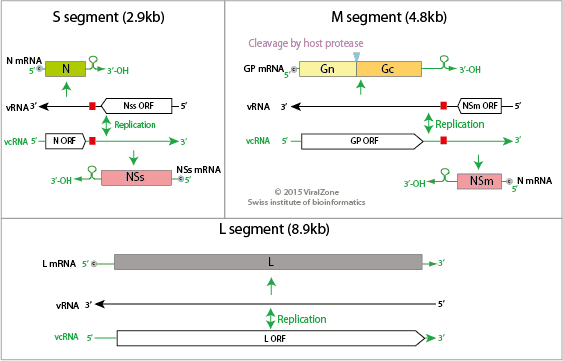 | ||
Lower classifications Tomato spotted wilt virus, Impatiens necrotic spot virus | ||
The tospoviruses are a genus (Tospovirus) of negative RNA virus found within the family Bunyaviridae. They are the sole group of plant infecting viruses in this family, as all other described members of the Bunyaviridae infect animals. The genus takes its name from the discovery of tomato spotted wilt virus (TSWV) in Australia in 1915. It remained the only member of the family until the early 1990s when genetic characterisation of viruses discovered in plants became more common. There are now at least twenty viral species in the family with more being recorded and described on a relatively regular basis. Together, these viruses have been documented infecting over eight hundred different plant species from 82 different families.
Contents
- How to pronounce tospoviruses
- Genome
- Transmission
- Agricultural importance
- Diagnosis
- Epidemiology
- Management
- References
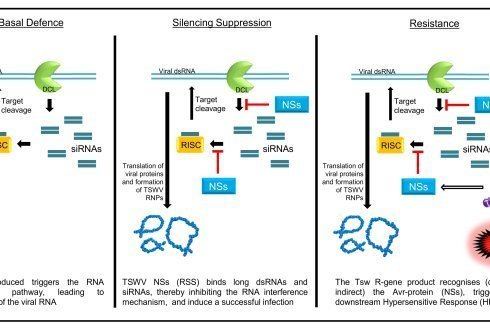
How to pronounce tospoviruses
Genome
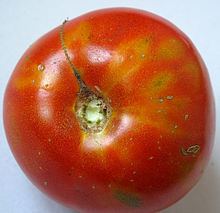
This virus has a single stranded RNA genome with negative polarity, therefore it is classified as a Class V virus ((-)ssRNA viruses). The structure of the genome resembles that of the genus Phlebovirus. The genome is linear and is 17.2 kb in size. It is segmented into three segments termed S (2.9kb), M (5.4kb) and L (8.9kb). The M and S RNA segments encode for proteins in an ambisense orientation.
Transmission
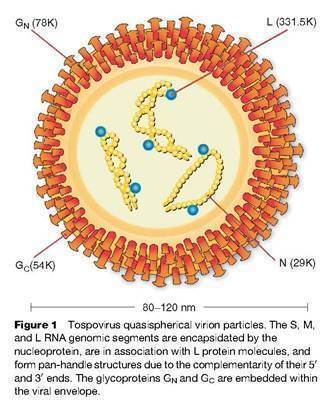
Tospoviruses are arboviruses usually vectored by thrips. At least ten species of thrips belonging to family Thripidae have been confirmed as vectors for the transmission of thirteen or more tospoviruses. The thrips vectors are not closely related, implying an independent origin of infection for each thrips, possibly transmitted horizontally through shared hosts. There may be other species of thrips competent to transmit similar viruses, but they have not been documented on crops of economic significance.
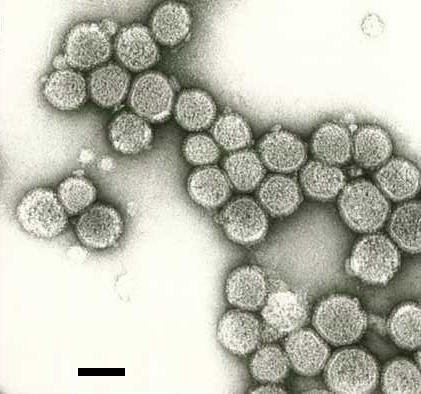
Recent research concludes that thrips can only be infected by tospovirus during the larval phases of development, as pupation and metamorphosis separate the connection between the salivary glands and the infected muscle tissue of the mid-gut. Adults transmit the virus from infected salivary glands, and uninfected adults will not transmit the virus. Obviously, controlling the infection by limiting transmission from infected plants to larval thrips or by preventing adult dispersal from infected plants are key strategies in preventing an epidemic of the disease.
Agricultural importance
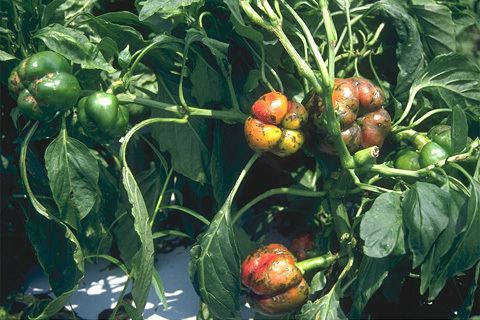
Infection with the virus results in spotting and wilting of the plant, reduced vegetative output, and eventually death. No antiviral cures have been developed for plants infected with a Tospovirus, and infected plants should be removed from a field and destroyed in order to prevent the spread of the disease.
A large number of plant families are known to be affected by viruses of the Tospovirus genus. These include both food crops (such as peanuts, watermelons, capsicums, tomatoes, zucchinis, et al.) as well as ornamental species which are important to flower farms (calla lily, impatiens, chrysanthemums, iris, et al.). For a more complete list of hosts examine the Tospovirus host list at Kansas State University.
Diagnosis
Early symptoms of infection are difficult to diagnose. In young infected plants the characteristic symptoms consist of inward cupping of leaves and leaves that develop a bronze cast followed by dark spots. As the infection progresses additional symptoms develop which include dark streaks on the main stem and wilting of the top portion of the plant. Fruit may be deformed, show uneven ripening and often have raised bumps on the surface. Once a plant becomes infected the disease cannot be controlled.
Serological and molecular tests are commercially available to diagnose TSWV as well as a second common tospovirus found in ornamentals, Impatiens necrotic spot virus (INSV). Cytological studies of TSWV and INSV have shown that these viruses produce granular inclusions in the cytoplasm of infected plants. These inclusions can be seen in the light microscope with proper staining techniques. These inclusions can be diagnostic.
Epidemiology
TSWV is prevalent in warm climates in regions with a high population of thrips. This virus is an agricultural pest in Asia, America, Europe and Africa. Over the past 15 years outbreaks of Tomato spotted wilt disease have become more prevalent in these regions. Therefore TSWV is described as an emerging viral disease of plants. The increased prevalence is largely because of the successful survival of the thrips vector Frankliniella occidentalis. Another thrips, Scirtothrips dorsalis, has also been implicated in the transmission of at least three tospoviruses, but there remains some controversy over its efficiency as a vector. Immunological testing and vector-competence studies suggest that S. dorsalis may represents a non-transmitting carrier for some strains of virus.
The success of this virus has also been attributed to the acquisition of a gene in the M segment of the genome which encodes a movement protein. This protein allows the virus to infect a wide range of hosts. The gene encoding this protein was likely acquired by recombination from either a plant host or from another plant virus.
Management
Control of this disease is difficult. One of the reasons for this is that the wide host range allows the virus to successfully overseason from one crop to the next. To prevent spread of the virus infected plants should be immediately removed away from neighbouring plants. Control of insects, especially thrips, is important to reduce spread of the virus by vectors.
